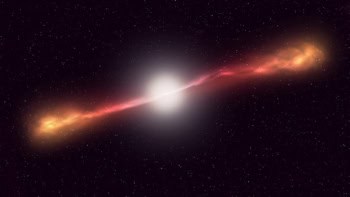
A cosmic-ray particle with an energy about 36 million times greater than the particles accelerated by CERN’s Large Hadron Collider has been detected. At 244 EeV, this is one of the most energetic particles ever observed and was spotted in 2021 by the Telescope Array in Utah. While the ultrahigh-energy cosmic ray (UHECR) was probably created by a violent astrophysical process, researchers were unable to trace it back to its origins.
The researchers have dubbed the particle Amaterasu, which is the goddess of the Sun in Japanese mythology. The current energy record for a UHECR is 320 EeV, held by the “Oh-My-God” particle, which was detected in 1991 in Utah by a predecessor to the Telescope Array.
UHECRs are subatomic particles such as protons that have energies greater than 1 EeV (1018 eV). While they appear to come from outside the Milky Way, their origins are still poorly understood due to the rarity of observing them on Earth.
Cosmic cut-off
In searching for the origins of UHECRs, astronomers benefit from a phenomenon called the Greisen-Zatsepin-Kuzmin (GZK) cut-off. This occurs because UHECRs with energies above about 60 EeV interact with the cosmic microwave background as they travel through space – losing energy as they go. This means that particles at these higher energies cannot have travelled further than about 300 million light–years before reaching Earth.
Despite this cut-off, the international team that detected Amaterasu is no wiser about the origin of the particle, according to Toshihiro Fujii of Japan’s Osaka Metropolitan University – who was first to notice evidence of the UHECR in Telescope Array data.
“We found this new mystery,” he said, pointing out that the particle does not correlate with any known astrophysical object. Writing in the journal Science, the team suggests several possible origins for Amaterasu.
Darkness and light
Looking within the GZK cut-off and assuming that the particle was deflected by the Milky Way’s magnetic field, one possible origin is galaxy NGC 6946. This is about 25 million light–years away and known for its prodigious star formation and numerous supernovae. However, astronomers have not observed gamma rays or X-rays from the galaxy. Observing this radiation would suggest the presence of an astrophysical object capable of accelerating UHECRs. Amaterasu could also be traced back the Local Void, a nearby region with an unusually low density of galaxies. But again, there is no object there that can be identified as a source.
According to the team, another possibility is that our incomplete understanding of particle physics beyond the Standard Model could mean that Amaterasu travelled farther than allowed by the GZK cut-off. If this is the case, then it could be that the UHECR’s origin is so far away that we cannot detect its electromagnetic emissions.
According to Fujii, the most exotic possible source of Amaterasu is a “dark accelerator” – a hypothetical object that emits UHECRs but no other radiation.
Despite the discovery and speculation, Rafael Alves Batista, an astrophysicist at the Autonomous University of Madrid, told Physics World that the observation reveals “nothing new” about UHECRs.
“I’m a conservative in the sense that I would not jump into any explanation beyond the Standard Model,” he says. “We have astrophysical objects that can indeed generate these high energy cosmic rays. We just don’t know how this happens, or where these objects are, or which objects are doing this.”
He also points out that astronomers have a very poor understanding of magnetic fields outside the Milky Way, which makes backtracking very difficult.
Complete uncertainty
“In our galaxy, we don’t really know [the galactic magnetic field] but at least we have a handle that it’s within specific bounds. But, for extra galactic magnetic fields, it’s completely uncertain,” Batista said.
Both Fujii and Batista agree that more observations of these rare events are needed before we can begin to understand the origins of UHECRs. Also needed are improvements to our understanding of extragalactic magnetic fields.
Some of these observations will surely be made by the Telescope Array. It is the largest cosmic-ray detector in the northern hemisphere and is currently being expanded to be a factor of four larger than its current area.
Today, particles like Amaterasu are detected about once every 15 years, but Fujii says improvements to the Telescope Array could reduce this to once every four years.
The research is described in Science.



